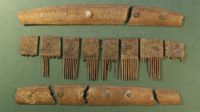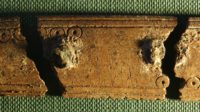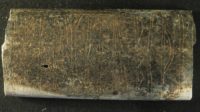 Archaeologists excavating the ancient market square in the city of Ribe in southwest Jutland, Denmark, have unearthed a comb from around 800 A.D. that is inscribed with the word “comb” written in runes. They also discovered a second runic inscription on a plaque of bone or antler that has yet to be deciphered.
Archaeologists excavating the ancient market square in the city of Ribe in southwest Jutland, Denmark, have unearthed a comb from around 800 A.D. that is inscribed with the word “comb” written in runes. They also discovered a second runic inscription on a plaque of bone or antler that has yet to be deciphered.
This is a sensational find, especially for Denmark. Runic inscriptions of any date are rare in Denmark; runes dating to the 9th century are exceptionally rare in Scandinavia period. Almost all of the runes from that period are carved on runestones, not inscribed on combs or bone plates. (Interestingly enough, the oldest Germanic language discovery ever made in central Germany were 3rd century runes also inscribed on a comb.)
So few runes have been found in Denmark that the discovery of two runic inscriptions from around 800 A.D. doubles the number of rune-engraved artifacts found in Ribe. The oldest extant town in Denmark, Ribe was already bustling in 793 A.D. when Viking raiders pillaged the monastery of Lindisfarne launching the Viking Era. Archaeologists have found evidence, however, of peaceful trade between the Norse of Norway and Denmark in Ribe. During an earlier dig season at the Ribe marketplace, antlers from Norwegian reindeer were found. They date to 725 A.D., which means the Norse were already taking on significant sea voyages and engaging in lucrative transactions with their neighbors long before the accepted date of the Viking Era.
 Given its history as a market city big enough to attract business from elsewhere in northern Europe, the comparative lack of runes on the archaeological record is puzzling. The runic alphabet was undergoing a seachange when Norsemen were trading reindeer antlers in Ribe, with the more complex Elder Futhark giving way to the newly succinct 16-letter Younger Futhark. The transition took place gradually over the 7th and 8th centuries, but by the early 9th, largely coinciding with the arrival of the Viking Era, the Younger had decisively overthrown the Elder. Researchers have been hoping to find more runes from this pivotal transition phase to shed new light on the transition to Younger Futhark and the role the towns played in the shift.
Given its history as a market city big enough to attract business from elsewhere in northern Europe, the comparative lack of runes on the archaeological record is puzzling. The runic alphabet was undergoing a seachange when Norsemen were trading reindeer antlers in Ribe, with the more complex Elder Futhark giving way to the newly succinct 16-letter Younger Futhark. The transition took place gradually over the 7th and 8th centuries, but by the early 9th, largely coinciding with the arrival of the Viking Era, the Younger had decisively overthrown the Elder. Researchers have been hoping to find more runes from this pivotal transition phase to shed new light on the transition to Younger Futhark and the role the towns played in the shift.
Archaeologists were especially interested to find out whether the script on the comb and plate were the new alphabet, which came into use at the beginning of the Viking Age.
Previously, the Vikings used a more complicated alphabet known as the 24 character futhark—itself a combination of the first six letters of the alphabet.
“It was built up so each rune had its own name and indicated the sound. But as the language developed, the names and sounds changed too, and in the end it was too difficult to remember the sound value of each rune and there was too much uncertainty in the message being conveyed,” says rune expert Lisbeth Imer from the National Museum of Denmark.
“At some point they decided not to use the old system anymore,” says Imer, who was invited to Ribe to study the two new discoveries and decipher whether it was the old or new alphabet.
 Imer found that both inscriptions were written in Younger Futhark, just the linguistic jackpot they were hoping for. The word “comb” in inscribed on both sides of the comb, although they are different parts of speech. The verb “to comb” is on one side, the noun “comb” on the other. The handwriting suggests the inscriptions may have been carved by two different people.
Imer found that both inscriptions were written in Younger Futhark, just the linguistic jackpot they were hoping for. The word “comb” in inscribed on both sides of the comb, although they are different parts of speech. The verb “to comb” is on one side, the noun “comb” on the other. The handwriting suggests the inscriptions may have been carved by two different people.
The runes on the bone plate are fragmentary — both ends are missing — and the piece was damaged by fire at some point making it even more difficult to read. It is clear that the text was engraved by one person, someone with a fine hand who could pull a proper line. He did not use the markers which denote the beginning and end of a word, so while the inscription is in theory decipherable, it’s difficult and experts haven’t cracked it quite yet.
Here’s Imer giving it a go in this video:
That seems to be indeed younger, as it reads -more or less- K-A-B-A-R, and seemingly, the -M- went missing somewhere in the process. Unfortunately, I do not know anything about this, but as the ‘older’ -M- seems to differ a lot from the younger one, our ‘scribbler’ left it probably out in doubt 😉
The other inscription seems to be something like K-I-R-M-I-T-U-B-I-Th-I ..or.. KIRMI TU BITHI ..or.. KIR MI TU BI THI .. and it does indeed feature an ‘M’. Luckily, I do in fact speak ‘Germanic’ very well, and the meaning *might* be here something like ‘keep me at hand’ (i.e. ‘with you’).
Confusingly, however, I could not say which inscription goes where, and which one of them, in contrast to all of that, is supposed to be the verb “to comb”, … but –frankly– I wont lose my not so feeble hair over this 😆
In addition, I could come up with the verbs (to) ‘guard’ and (old german, now extinct) ‘kirren’.
There is an Anglo-saxon noun ‘ceren’ (a ‘churn’ – vas in quo lac agitatur et butyrum cogitur – i.e ‘butter’ was made in those). Moreover, ‘Karner’ is a term for ossuary, ‘vas in quo’ bones are kept.
What I did so far not know, by the way, is that ‘butter’ is derived from βούτυρον, βοῦς (a term for ‘cow’) …Mooo !
I am from Luxembourg, and we have “kieren” in luxembourgish.
de Haff kieren (letzebuergesch)
den Hof kehren (Deutsch)
to sweep the courtyard (English)
maybe to sweep your hair?
Tom, ‘kieren/kehren’ and the extinct ‘kirren’ seem to be different to me (which wont mean anything, of course). One might argue that you keep your ‘Heff’ -or hair- in shape: “Sie kommt! sie ists! ich will sie kirren, s’ist auch ein Mädchenhaupt, ich wills verwirren.”
Disturbingly, the -Ancient- Greek verb κορέιν (i.e. ‘to sweep out’) is a synonym for the -modern- Italian ‘scopare’, which notably -in vulgar(!) terms- can also mean, what κορεύομαι meant back then. Maidens (κόρη), in this cruel deranged world, it seems, swept courts for millenia.
Contrastingly, ‘licens’ (Lat. free, unrestrained, bold) seems to be connected to ‘kirren’ -according to what I saw- via ‘allicere’ – to (al)lure. If so, you really seem to have a point here, Sir (you found a hair). In Greece, I am afraid, they seem to have (had) the wrong attitude.
What was here seemingly rendered into ‘Germanic’ as “kirmitubithi” might have been a (Latin) “vademecum” (a ‘go with me’). Apart from that, an “eli-M-inination of ‘M’s” is likewise taking place elsewhere (I collected some ‘hairy’ -and maybe not so hairy- examples):
‘Kombüse’ vs. ‘ca(m)boose’, there is ‘cabaña’ (no ‘m’) vs. ‘camp’, and also a term for clay pot or ‘karamba’ in ‘dupanin(g)an agta’ (spoken by the semi-nomadic Negrito people in northern Luzon in the Philippines) vs. the German ‘Karaffe’ or the Spanish/ Arab ‘garaffa’ (no ‘m’).
——————
PS: I just saw the video and -frankly- I am not so sure if there really was a fair-haired Viking by the name of “Toby” 😉
I saw photo of the comb when it was being excavated. It’s a miracle they got it out w/o it crumbling to bits. Nice job by the folks who freed and restored it.
Lice would have been an everyday part of life then. Perhaps that’s why the tines are so close together?
When Charles the Great occupied frisia around 770 the frisian king Redbad fled to Denmark to the region we now know as North frisia. Ribe is very close to this region and Ribe has a lot frisian influences round 800. I am frisian and fluent frisian speaking. What i see in it is: KIR (turn), MI (me), TU (to), BI (with), THI (you).
Return me to with you
Like a wish that some one comes back to be with him/her.
KIR: return in frisian and german “keren” “keer”
THI: frisian english “Thy”
BI: frisian “by” translates to “with”
I don’t have any experience with runes, but these are just my thoughts
The plate clearly says .:farmatý biþa:. Would mean “bid/pray/ask the cargo-god”.